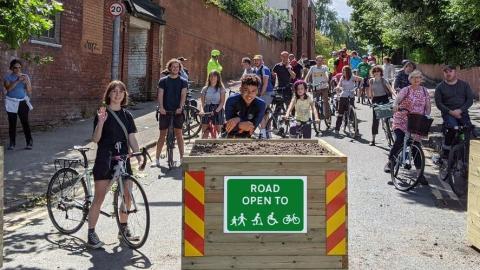Active Neighborhoods

About this good practice
The Bee Network, outlined in TfGM's Made to Move plan, aims to create a cycling and walking network, comprising of three elements: the main road corridors, the crossing points and the active neighbourhoods. An Active Neighbourhood (AN) intends to create a ‘filtered’ neighbourhood, reducing through-traffic in the area and encouraging residents to walk and cycle for local trips. Data shows that currently many of these journeys are being done by private car which has many negative impacts including on public health and inactivity, local environment and air quality, and CO2 emissions.
TfGM took the opportunity to kick-start the AN part of the programme with the view to demonstrate if these schemes can be delivered at low cost in every district.
Active Neighbourhood schemes have the ability to be relatively low cost and high impact. Expected benefits locally are modal shift from vehicles to active travel demonstrated by a reduction in vehicle traffic in each neighbourhood and an increase in the number of people walking and cycling, as well as improving the sense of place. Environmental benefits are also expected from creating spaces for people rather than vehicles, and from reduced air pollution. Community involvement to bring benefits to social cohesion and community ownership of the local area.
Resources needed
Cost: Estimated cost of £2.8m, of which £1m is being requested for development costs.
Evidence of success
As this scheme is still in its early stages, no evaluation of the impacts have been assessed. Despite this, perception surveys indicate that some 68% of residents were in favour of the measures.
Similar project across the UK give very encouraging results.
In Dulwich, London, the volume of motor traffic decreasing in some cases by 79%, and at its peak, cycling levels around Dulwich Village increasing by 103%. The volume of
cycles on external streets has increased by between 43% to 70%31.
Potential for learning or transfer
AN's deemed sufficient for transfer mainly due to its low cost, high impact potential. A successful AN project requires very little expensive infrastructure. Indeed, in certain cases, this can be limited to road barriers such as large planters or bollards. AN's can be used as a supplementary measure to larger projects such as cycle highways, and bus infrastructure improvements.
The benefits can not only be seen in the increase in active travel rates, but also, urban realm improvements, air quality and social cohesion.
Though this practice has many associated benefits, these benefits can only be realised through a programme of meaningful and intensive public engagement. Often, AN's are looked at with some skepticism from residents that are directly impacted by them, and this can come with political objection. Early engagement and community participation of the project has proven that these initial objections are often removed.
Further information
What is an Active Neighbourhood?
Images

Website
Good practice owner
You can contact the good practice owner below for more detailed information.